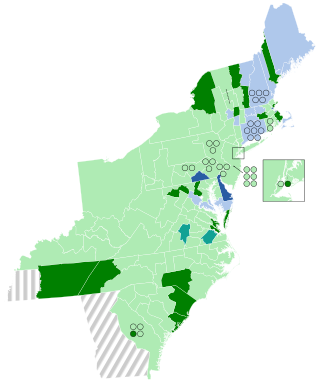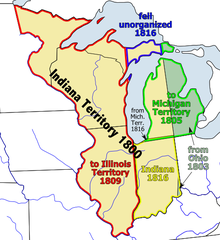
The Indiana Territory, officially the Territory of Indiana, was created by an organic act that President John Adams signed into law on May 7, 1800, to form an organized incorporated territory of the United States that existed from July 4, 1800, to December 11, 1816, when the remaining southeastern portion of the territory was admitted to the Union as the state of Indiana. The territory originally contained approximately 259,824 square miles (672,940 km2) of land, but its size was decreased when it was subdivided to create the Michigan Territory (1805) and the Illinois Territory (1809). The Indiana Territory was the first new territory created from lands of the Northwest Territory, which had been organized under the terms of the Northwest Ordinance of 1787. The territorial capital was the settlement around the old French fort of Vincennes on the Wabash River, until transferred to Corydon near the Ohio River in 1813.

Since Utah became a U.S. state in 1896, it has sent congressional delegations to the United States Senate and United States House of Representatives. Each state elects two senators to serve for six years. Before the Seventeenth Amendment in 1913, senators were elected by the Utah State Legislature. Members of the House of Representatives are elected to two-year terms, one from each of Utah's four congressional districts. Before becoming a state, the Territory of Utah elected a non-voting delegate at-large to Congress from 1850 to 1896.

These are tables of congressional delegations from Indiana to the United States House of Representatives and the United States Senate.
Non-voting members of the United States House of Representatives are representatives of their territory in the House of Representatives, who do not have a right to vote on legislation in the full House but nevertheless have floor privileges and are able to participate in certain other House functions. Non-voting members may vote in a House committee of which they are a member and introduce legislation.

Texas's 11th congressional district of the United States House of Representatives is in the midwestern portion of the state of Texas, stretching from the Permian Basin through the Hill Country. Major cities in the district are Andrews, Midland, Odessa, San Angelo, and Brownwood. The current Representative from the 11th district is Republican August Pfluger.

The 1804–05 United States House of Representatives elections were held on various dates in various states between April 24, 1804 and August 5, 1805. Each state set its own date for its elections to the House of Representatives before the first session of the 9th United States Congress convened on December 2, 1805. The elections occurred at the same time as President Thomas Jefferson's re-election. Elections were held for all 142 seats, representing 17 states.

In 1798, the Northwest Territory became eligible to send a non-voting delegate to the U.S. Congress. The Assembly elected this representative.

New York's 26th congressional district is a congressional district for the United States House of Representatives in Western New York. It includes parts of Erie and Niagara counties. The district includes the cities of Buffalo, Lackawanna, Niagara Falls, Tonawanda, and North Tonawanda.

Illinois Territory's at-large congressional district was a congressional district that encompassed the entire Illinois Territory. The territory was established on March 1, 1809 from portions of Indiana Territory. The district elected a non-voting delegate to the United States House of Representatives.

Katie Beatrice Hall was an American educator in Gary, Indiana, and a politician who served as a U.S. Representative from Indiana from 1982 to 1985. When Hall was sworn into federal office on November 2, 1982, she became the first black woman from Indiana elected to the U.S. House of Representatives. Hall represented Indiana's 1st Congressional District in the final months of the 97th Congress and an entire two-year term in the 98th Congress from 1983 to 1985. She is best known for sponsoring legislation and leading efforts on the floor of the U.S. House in 1983 to make Martin Luther King Jr.'s birthday a national holiday after previous efforts had failed. H.R. 3706 to establish the third Monday in January as a federal holiday in King's honor was introduced in July 1983 and passed in the House on August 2, 1983. President Ronald Reagan signed the bill into law on November 2, 1983.

Oregon's 2nd congressional district is the largest of Oregon's six districts, and is the seventh largest district in the nation. It is the second-largest congressional district in the nation that does not cover an entire state, and has been represented by Republican Cliff Bentz of Ontario since 2021.

Indiana's 7th congressional district is a congressional district in the U.S. state of Indiana. It is entirely located within Marion County and includes most of Indianapolis, except for the southern side, which is located within the 6th district.

Oklahoma's 3rd congressional district is the largest congressional district in the state, covering an area of 34,088.49 square miles, over 48 percent the state's land mass. The district is bordered by New Mexico, Colorado, Kansas, and the Texas panhandle. Altogether, the district includes a total of 32 counties, and covers more territory than the state's other four districts combined. It is one of the largest districts in the nation that does not cover an entire state.
Wisconsin Territory had a non-voting delegate to the United States House of Representatives.

Cecil Murray Harden was an American educator who became a Republican politician and an advocate of women's rights. She served five terms in the U.S. Representative representing Indiana's 6th congressional district. Harden was the only Republican woman elected to represent Indiana in the U.S. Congress until 2012, when Susan Brooks and Jackie Walorski were elected to serve in the 113th United States Congress beginning in January 2013.

Iowa Territory's at-large congressional district is an obsolete congressional district that encompassed the area of the Iowa Territory, which was split off from the Wisconsin Territory in 1838. After Iowa's admission to the Union as the 29th state by act of Congress on December 28, 1846, this district was dissolved and replaced by Iowa's at-large congressional district.

Idaho Territory's at-large congressional district is an obsolete congressional district that encompassed the area of the Idaho Territory, which was originally created from parts of the Washington Territory and Dakota Territory in 1863. In 1864, parts of the territory were ceded back to the Dakota Territory and another part was reorganized into the Montana Territory. The boundaries of the territory were changed again in 1868 when the Wyoming Territory was created.

New Mexico Territory's at-large congressional district is an obsolete congressional district representing the New Mexico Territory, which was created in 1850. After New Mexico's admission to the Union as the 47th state by act of Congress on January 6, 1912, this district was dissolved and replaced by New Mexico's at-large congressional district.

Benjamin Parke was an American lawyer, politician, militia officer, businessman, treaty negotiator in the Indiana Territory who also served as a United States federal judge in Indiana after it attained statehood in 1816. Parke was the Indiana Territory's attorney general (1804–1808); a representative to the territory's first general assembly (1805); its first territorial delegate to the United States House of Representatives (1805–1808); one of the five Knox County delegates to the Indiana constitutional convention of 1816; and a territorial court judge (1808–1816). After Indiana attained statehood, Parke served as the first United States District Judge of the United States District Court for the District of Indiana (1817–1835).



















